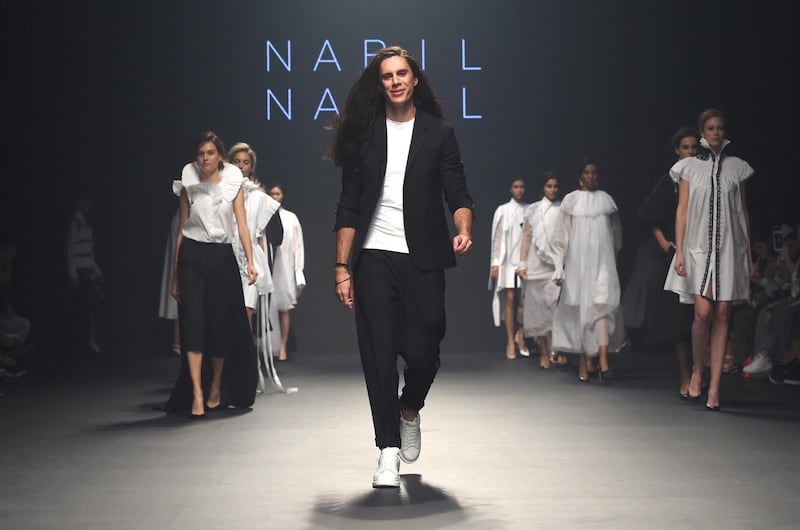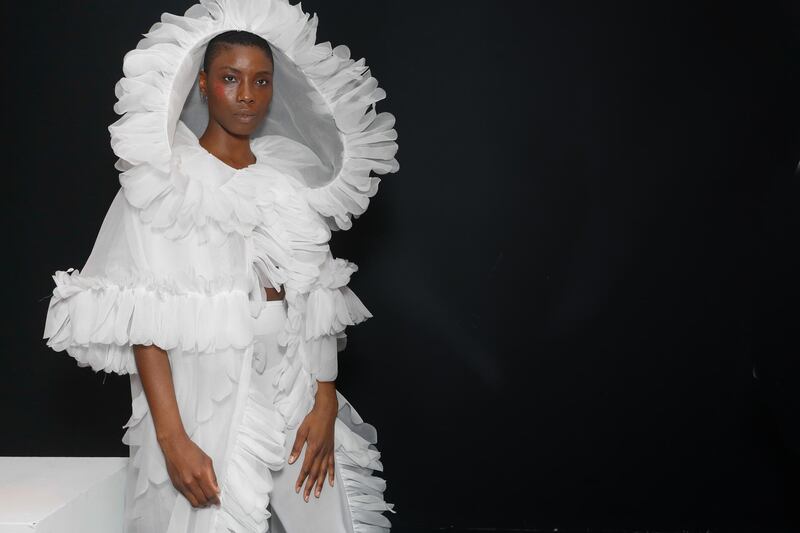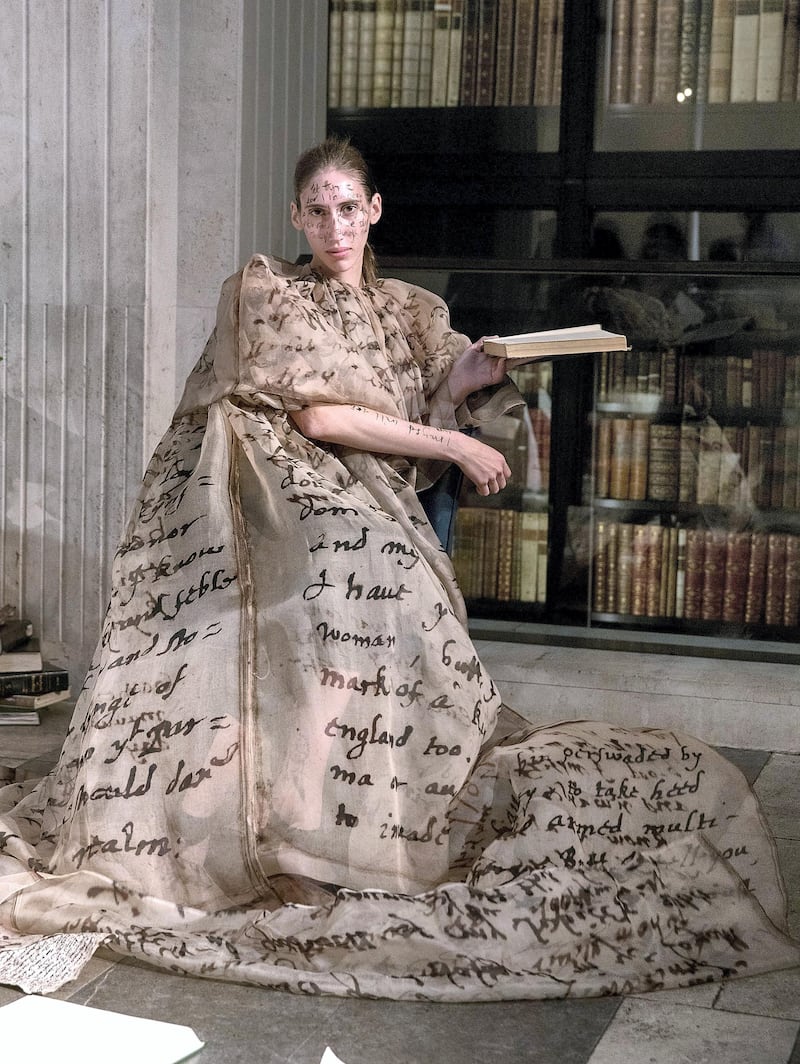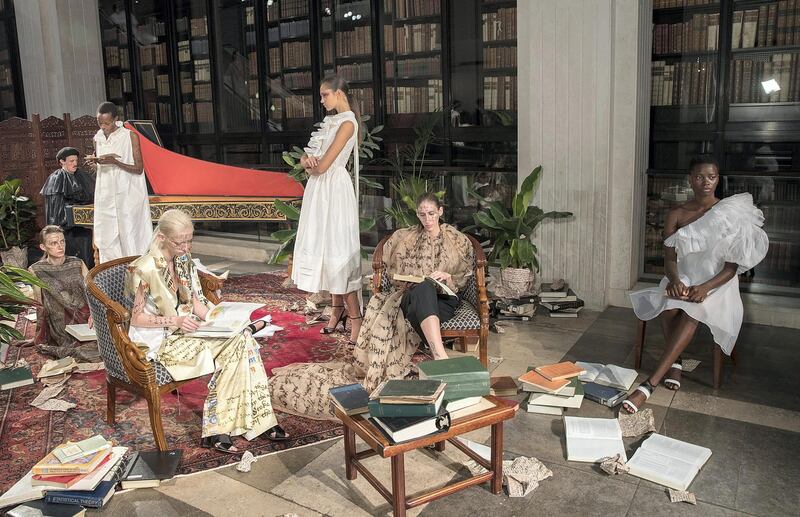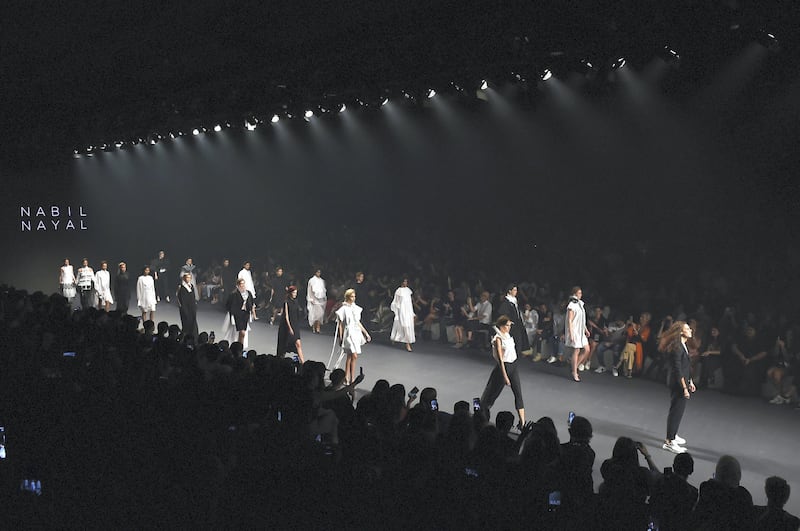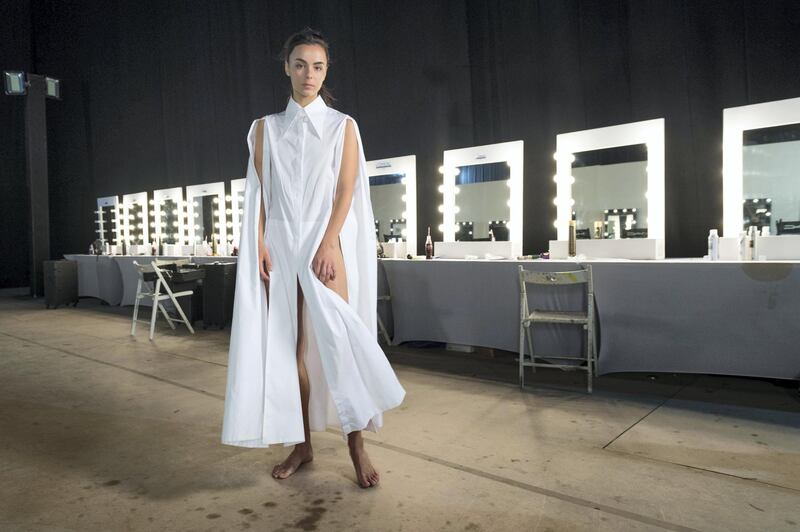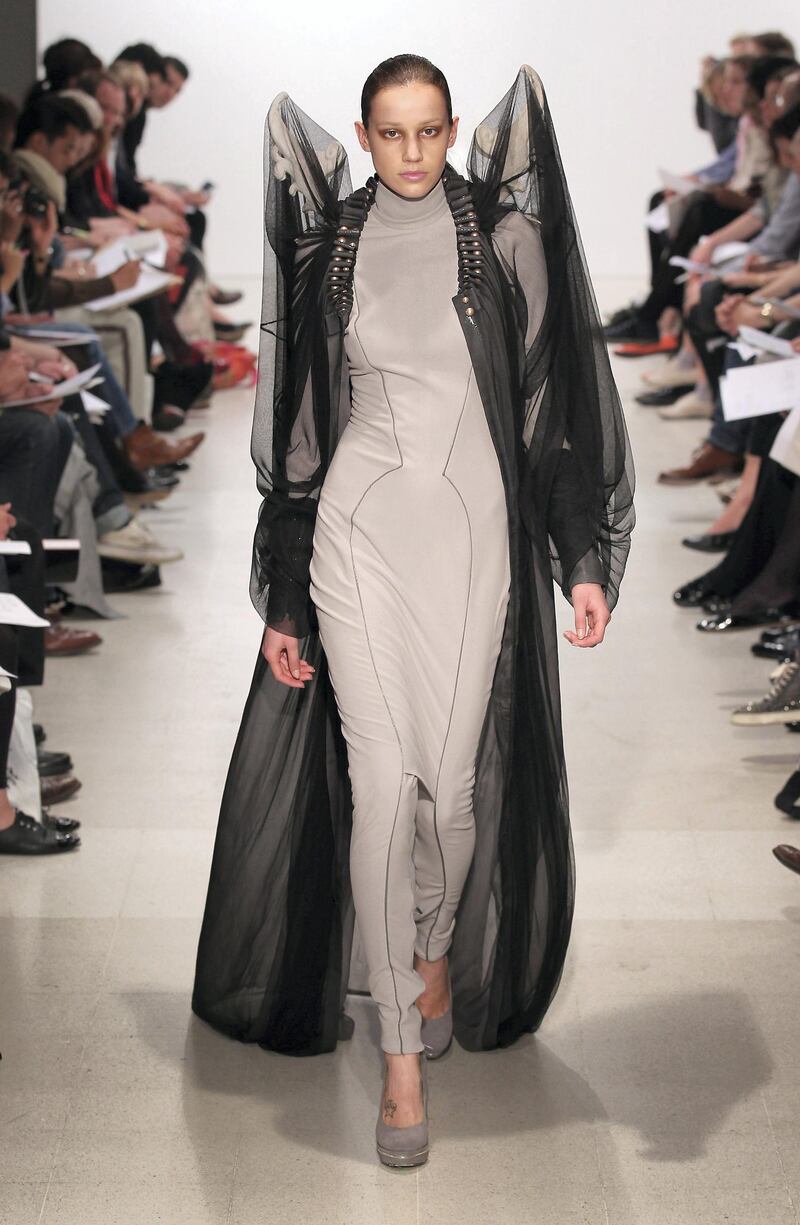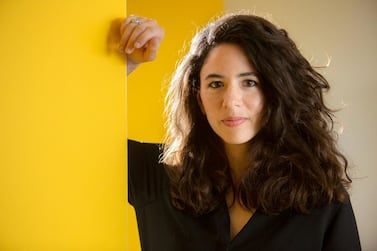Nabil El-Nayal has vivid memories of his grandfather’s textile shop in the Al-Madina Souq within the walled ancient part of Aleppo.
As a young boy, Nabil would pass through the long, arched alleys of the 14th-century covered market every Friday after prayers.
Nayal can still hear the sound his small feet made on the cobblestones en route to the family shop where he clambered on to the bolts of fabric to snip off scraps of the materials he liked best.
Now the fashion designer, who has not been back to his birthplace in decades, is returning to his roots via Syria’s rich textiles, paying homage to the centuries of craftsmanship that are little known outside the Levant.
On his desk at home in London is a stack of fabrics that his father, Ghassan, 66, brought back from Aleppo two years ago. The trip, made when Nayal's paternal grandmother, Aziza, died, was the first time he had returned since war broke out in 2011.
"He sent pictures of all the toys and things we left behind in our house, which were covered in dust, and it triggered an emotional reaction in me," Nayal tells The National.

“I felt I needed to reconnect with Hallab,” he says, using the Arabic name for Aleppo. “I gave him a brief and he came back with all these striped fabrics in different colours. Although I haven’t used them yet, I know they will be important.
“I can even smell the textile shop on them and it connects me back to my youth, my city and my country. It shows the kind of bond you can have, not only to your identity and culture but to fabrics that speak to your background and history.”
To fans of his work – among them the likes of Rihanna, Victoria Beckham, Lady Gaga, Florence Welch and Jerry Hall – it might seem an unlikely departure from the Elizabethan-inspired ruffled shirts and voluminous, pleated smocks with which he made his name.
For Nayal, 35, born to an English mother and an Arab father, it is simply an exploration of his dual identity and the next natural step of a journey he began with the first stitch he sewed as a toddler.
“My work now tends to be towards my cultural identity, which is other – being in between Syria and the UK, and being English but also Arab,” he says. “A lot of the dialogues I am having are about this kind of otherness.”
Nayal does not know when he will be able to return to Aleppo himself but, in the meantime, he is planning a visit to Jordan for a project to help women in the Zaatari refugee camp reconnect with their heritage through textiles.
He was born in 1985, the eldest of three children, after his father married his mother Victoria, a secretary, while studying for a doctorate in metallurgy at the University of Sheffield in England.
Ghassan went back to Syria in 1984 to help manage the family textile business, which included a cotton mill, left to him and his 10 siblings after the death of his father, Shakkar. Nayal’s heavily pregnant mother followed shortly afterwards and the couple set up home there.
Their circle of friends included an eclectic mix of Arab, American and British families living in Aleppo. Nayal went to an Arab school and became fluent in the language. Although his mother took longer to learn Arabic, she embraced the local culture and dress.
Nayal grew up in the constant company of a phalanx of strong, innovative female relatives, who taught him to sew and knit.

“I was surrounded by women who knew everything about clothes because that was often what they would make and wear,” he says. “I would not only learn about construction methods but what it means to wear something and how, and the ritual of dressing.
“My mother has been my muse since I can remember. She would wear the highest possible shoes, and merged cultures, wearing T-shirts and jeans but also jalabiyas, draping, tucking and knotting fabrics with decorative, rich colours. Creativity surrounded me in an indirect way all my life.”
Aziza showed him how to use her old Singer sewing machine. When only three years old, he tore down the net curtains from the windows of the family house and crudely hand stitched them together with green thread to make a dress for his mother.
“She was so positive about it that I think it gave me the ammunition to keep going,” Nayal says.
His father was more resistant. Fashion was not, to his mind, the done thing for a male but Nayal persisted. “In a way, it was a good thing because I had to defend it and fight for it,” he says.

When Nayal was 14, the family moved to Sheffield, partly to give him the education needed to follow his chosen career. The teenager thrived in history lessons but wasn’t academic and struggled to fit in at secondary school.
“In Syria, I was very much aware that I was different and I equally felt that when I came to the UK,” he says.
He went on to pursue a degree in fashion at Manchester Metropolitan University, winning the womenswear award at Graduate Fashion Week in 2008 and securing a scholarship from the British Fashion Council for a masters at the Royal College of Art in London.
On the judging panel was Christopher Bailey, then the creative director at Burberry, who praised the "beautiful lightness" in Nayal's work and invited him to spend time as a researcher with him.
The prize included the opportunity of designing a capsule collection for the retailer River Island. Nayal’s sold out within three days, and his MA collection was snapped up by Harrods.

He was also invited to show at London Fashion Week with his brand Nabil Nayal. “It was a whole other level,” he says. “Coming to London was eye-opening and really important to my education because I saw a different side of fashion.”
With his penchant for interpreting the historical context and cultural significance of fashion methods in a contemporary way, Nayal returned to Manchester Metropolitan University for a practice-based doctorate. Two of the resulting six collections were shortlisted for the LVMH prize for young fashion designers in 2015 and 2017.
At the first of these, Karl Lagerfeld famously stopped in his tracks before Nayal's signature white shirt, replete with Elizabethan-inspired drapes and pleating, and exclaimed: "I love it! I love it!"
The German creative director, a hero of Nayal’s, bought one of the pieces, making Lagerfeld his first real customer. “Which is still incredible,” the designer says.
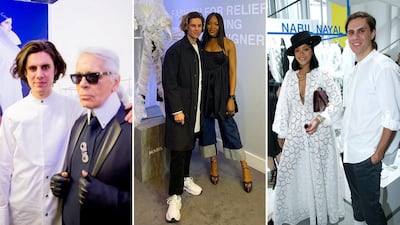
The awards catapulted him into the limelight, prompting pop stars and fashionistas to snap up the Nabil Nayal designs.
Nayal’s style is theatrical, with plenty of drama in the complex construction and layered folds of the pieces. They are given a twist with contemporary techniques, such as 3D printing and sportswear bonding, to update ancient crafting methods.
While exploring this concept of disruption, the designer realised that he was reflecting something within himself. “This idea of frictions and things breaking and colliding – that is in me because of my complex cultural identity,” he says.
“That is what I try to do within my practice, fusing the past and the future, whether it be historical dress and technology or looking at my cultural identity. These creative tensions and the collision of worlds lead to new ideas.
Nayal is still passionate about Elizabethan crafting methods, he says, but he is now researching historical Syrian dress. He has found that it is not well documented and, where records do exist, they are often refracted through an Orientalist prism.

“I created this identity and persona that was very British for a long time, and then it wasn’t until I did not need to fit in any more that I just allowed myself to be,” Nayal says.
“I’m proud of my Elizabethan work but it was only tapping into one half of me. To have and show a complete voice, I had to also tap into my Arabness, which I have been doing in the last year in more depth.”
When Covid-19 struck, his label was on sale from Bergdorf Goodman in New York to Selfridges in London. With shops closed, fashion weeks off the books or relegated online, and designers having to innovate to reconnect with audiences and customers, there has been time for reflection.
As a result, Nayal, who received emergency funding from the British Fashion Council, does not think he will heed the diktats of fashion seasons again. Instead, he will bring out smaller, more regular collections, and work on collaborations with museums and institutions.
It is an attitude that he sees in the design students at the London College of Fashion, where he is course leader on the master’s degree in womenswear. More and more, they are beating their own paths by developing personal relationships with their followers and no longer being beholden to the big fashion houses.
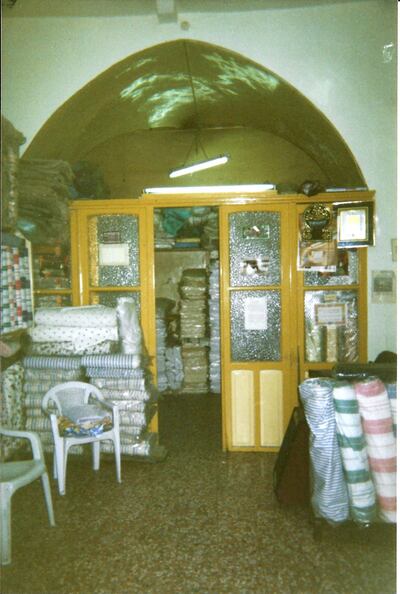
“I think this archaic showing twice a year and being so trend and consumer driven is really wrong,” Nayal says. “I want to tell meaningful stories and contribute positive change. I’m really questioning what fashion means to me and could mean as we enter this new decade.”
When he is not working or teaching, Nayal potters around the garden of his home in Sheffield or tends to the window boxes on the balcony of his north London flat where 130 plants jostle for space inside and out.
Thanks to fiery-coloured lantana and purple heart sourced from homeware stores, friends and eBay, it is like living in a jungle – something that delights his cat and propels Nayal “right back to that 12-year-old living in Aleppo”.
It has become another way to nurture the deep love he has for his homeland. “I’ve been on a mission to try to recapture what the plants of Syria look and smell like, and try to get them to grow in the UK,” he says, “which is challenging and does not always work out but I am really passionate about it.”
Nayal became green-fingered as a child, spending Fridays with Ghassan planting the shrubs that they brought back from their weekly trips to Al-Madina.
He tells me that the family business relocated some years ago to a safer part of Aleppo, now operating out of the ground-floor apartment where he grew up. His childhood bedroom has evolved into the shop front or, as Nayal puts it, “a souq”.
What will emerge from his studio next is yet a mystery, but it is clear that the boy who was born into textiles is about to fashion a future from his own past.
In an industry known for its repeated life cycles, it’s fair to say that this one is far from run-of-the-mill.
